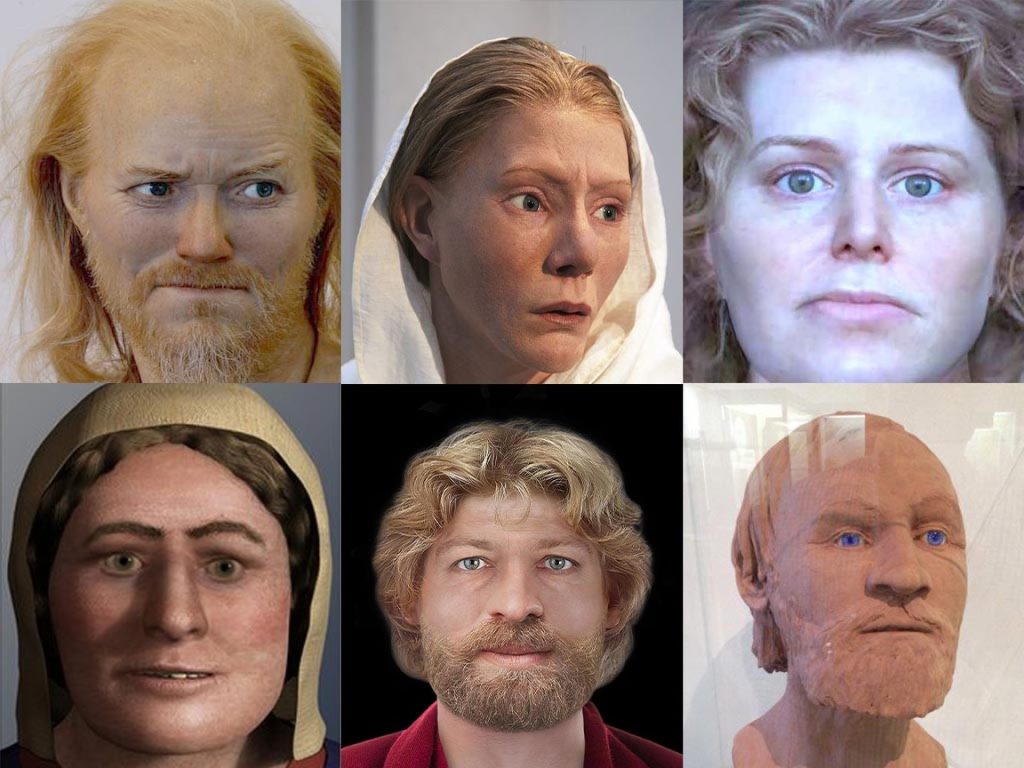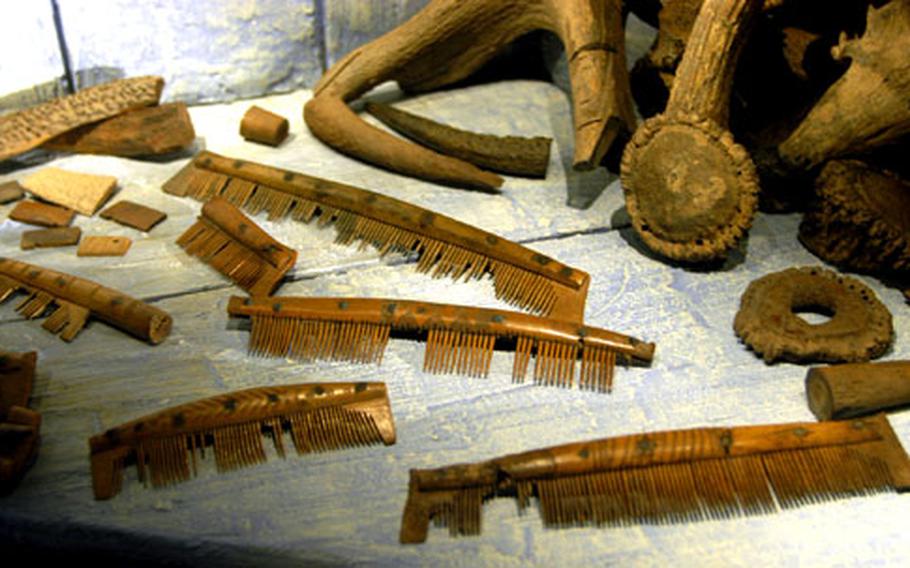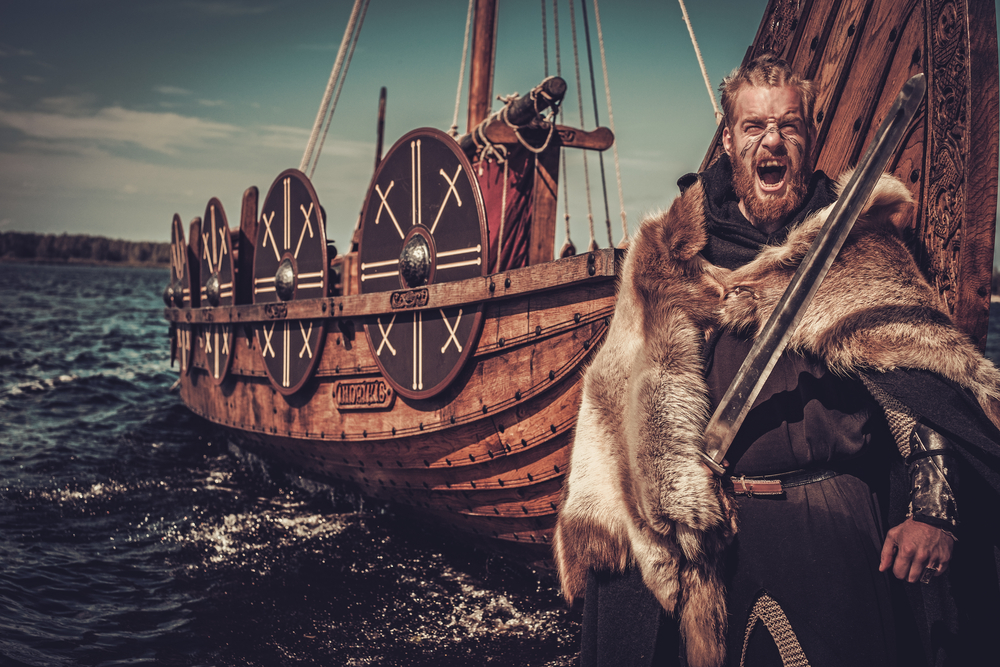Our popular image of Viking warriors and the gods of Norse mythology is one of tall, muscular blond warriors with beards and horned helmets. And this conception is not far off from the truth.
We can get a good idea of Viking age physical characteristics, clothing, and social habits from ancient texts, archaeological evidence, and historians.
How Long Did The Average Viking Live?
The typical Viking life expectancy was much lower than it is today. A man would live between 40 and 50, while the average lifespan of a woman was only 38, mainly due to the hazards of pregnancy and childbirth in the Middle Ages.
What Race Were Vikings?
The Vikings had a surprisingly complicated mix of races. Many were Sami, claiming ancestry from Scandinavia (Swedes, Danes, and Norwegians), while others were Southern Europeans or from Iceland, Greenland, and Britain.
The United Kingdoms established in Scandinavia coincided with the spread of Christianity across the region in the 10th and 11th centuries.
How Tall Was The Average Viking?
Recent Danish excavations of around 500 Viking skeletons have revealed that their average height was about 3 to 4 inches shorter than we are today.
An average man was 5 foot 6 inches tall, while a woman only measured 5 foot 1 inch.
Records of that time also mention the height of Vikings. Many travelers from the Middle East journeyed west into Northern Europe and recorded their experiences.
Ibn Fadlan
The Arab diplomat Ibrahim Ahmad ibn Fadlan reported meeting a group of Rus people in the Volga region of Russia.
I have seen the Rus as they came on their merchant journeys encamped by the Volga. I have never seen more perfect physical specimens, tall as date palms, blond, and ruddy. They wear neither tunics nor kaftans, but the men wear a garment that covers one side of the body, leaving a hand free.
Each man has an axe, a sword, and a knife at all times. The swords are broad and ground, of a Frankish sort. Each of them has a collection of trees, figures, and the like from their fingertips to their neck.
Ibn Fadlan Travels in Russia 922 – Legal History Sources
This description might signify that the Vikings he saw had tattoos; indeed, the art of tattooing was well-known to them.
The Annals of Fulda
Other sources, such as the Annals of Fulda in the East Frankish chronicles of 884, describe the Franks defeating a Viking raid in Saxony.
In that battle, such men are said to have been killed among the Northmen that had never been seen before among the Frankish people, namely in their beauty and the size of their bodies.
The Vikings on the Continent in Myth and History – Jstor org
Male and female Vikings are generally described as larger, stronger, and more muscular than the average person. The main reason for the difference lay in the strenuous manual labor that Scandinavians did to survive in their harsh landscape.
What Physical Traits Did Vikings Have?
Their facial features were also different from how they are today. Viking women and men were more alike than modern folk: the women had more prominent ridged brows, typical of males. In contrast, men had softer, more feminine features with a less pronounced jawline and more rounded brows.
These unisex characteristics can sometimes mean it is challenging to distinguish the sex of Viking-era skeletal remains, especially if the only bones available are skulls.

What was the most prominent Eye Color among Vikings?
Vikings had varying eye colors, the most common being blue or gray.
Some Irish Vikings had brown or hazel eyes. Green eyes are often typical of German or Celtic heritage and are common in Ireland, Scotland, and Iceland.
What Color Was A Viking’s Hair, And How Long Was It?
Old Norse society featured people with different hair colors, although blond and red were the most popular.
Blond hair was more typical of Northern Scandinavia, particularly around Stockholm in Sweden, while red hair was more common among Danish Vikings in Western Scandinavia.
”There was a mixture even back then because other cultures came to Denmark,” says Danish anthropological archaeologist Lise Lock Harvig.
How Did Viking Men Wear Their Hair And Beards?
Long hair and beards were extremely popular. So much so that some Vikings had nicknames like Sven Forkbeard or Harald Fairhair.
One of the most-used hairstyles in Denmark was the “backward” or “reverse mullet,” i.e., long hair at the front and shaved at the back. The character Bjorn Lothbrok from the History Channel TV series Vikings wore his hair in this style. Some writers believe the back of the head was shaved to prevent bowstrings from catching on it.
Although beards were very typical, they were not universal, and Viking society liked to dress in a way that expressed their individuality.
From the number of combs, ear cleaners, and tweezers excavated, we know that grooming and good personal hygiene were prevalent in Viking culture.

How Did Female Vikings Wear Their Hair?
Women took care of their hairstyles and often used beads or other accessories to decorate their long hair.
What Was A Viking’s Personal Hygiene Like?
It was rumored that English women found Viking men attractive as they looked and smelled good and dressed well.
Unlike the English men of the time, Vikings took a bath every Saturday. Today, “lørdag,” the Danish word for Saturday, comes from the Old Nordic word “Lagerdag,” which means “Washing Day.”
*Check my article on days of the week named after Norse deities.
Their generally pastoral existence meant that infestations of lice and nits were common. Soaking in urine was a common way to disinfect clothes, as was using it to clean your hair.
Lye soap was developed to make that process a little easier – its main ingredients were leached wood ash and boiled animal fat.
Did The Vikings Wear Makeup?
According to, Ibrāhīm ibn Ya’qūb al-Isrā’īlī al-Turtūshī, a Spanish Arab who visited Hedeby, near the southern end of the Jutland Peninsula, around 1,000 AD, Viking men, and women wore “kohl,” a form of indelible makeup.
What Was Viking Clothing Like?
Vikings were no different from other societies regarding fashion and a desire for quality clothing.
Viking clothing was not merely practical but also a way of showing your social status and appealing to the opposite sex.
Archaeological Evidence
Unfortunately, clothing does not last. Archaeological discoveries are usually limited to small scraps of cloth, like wool or linen, so any idea of the patterns, outfits, and styles is difficult to ascertain.
We have to use texts, statues, and depictions to understand better how this clothing looked, for example, the miniature Valkyrie figurine found near the village of Hårby on the island of Funen in Denmark.
The Bayeux Tapestry in France also provides an idea of how the Vikings might have dressed.

Clothing Colors
Vikings commonly used dyeing techniques to color their clothing. The most popular color for Viking apparel was red, obtained from the plant called “madder.” Madder did not grow in Scandinavia, and the Vikings had to trade for it in Frankia or Saxony or from traveling sellers. Its scarcity meant it was costly and red clothing was an important status symbol in Nordic culture.
Other colors like black, yellow, blue, purple, and white were more readily available.
Patterns And Symbols
We can see from the preserved fabric that the Vikings liked patterns and symbols on their clothing, ribbons, and other adornments.
Layered Clothing and Accessories
Vikings liked to wear their clothing in layers to keep warm. There were regional variations on a common theme, with most men wearing a short or long-sleeved tunic as an outer garment. These tunics were relatively long and reached down to the knees. They didn’t have buttons and were pulled on over the head. The men wore trousers of linen or wool.
Many belt buckles have been found in excavations, so we know these trousers were held up with a belt, probably made of leather. Poorer people or slaves would use a simple drawstring to keep their pants up.
Trousers would vary from tight to baggy and decorative to plain. A simple, thinner set of tunic and trousers also served as underwear.
On the outside of their trouser bottoms, they wore woolen bindings wrapped around the foot up to the knee. These were worn across Scandinavia but, curiously, were not typical in Iceland.
Cloaks And Brooches
Vikings would also wear cloaks in harsher weather or to conceal weapons. The more brightly colored and finely crafted ones would be reserved for the wealthier members and jarls (chiefs) of the Norse settlement. Silk clothing was also available to the Vikings, but it had to be imported from the Middle East and was very expensive.
The brooches used to fasten these cloaks could be made of base or more precious metals and have several designs ranging from disc to penannular.
Exterior clothing was often made of animal skin and treated with beeswax and fish oil to make it waterproof.
Women’s clothing consisted of ankle-length linen underdress with a slightly shorter dress of a heavier material worn over it. An iron or bronze “tortoise” broach on either side attached the straps to the dress.
As with the men’s outfits, they were no pockets – Vikings preferred to carry their items in a bag tied to a narrow belt.
Undergarments
Danish women of the Viking age preferred plain undergarments, while Swedish ones wore them with pleats.
Vikings used the technique of “needle binding” and not knitting to make their socks. This method was more complicated but made them much more resilient. Poorer people would have to make do with hay or moss stuffed into their shoes.
Needle binding was also used to make hoods, caps, scarves, and mittens, although these were also manufactured from animal skin, such as rabbit or sheep.
Jewelry
Viking women commonly wore necklaces of amber beads as jewelry and hung practical items around their necks, such as scissors or whetstones.
Jewelry was extremely popular in Viking culture, and they were experts at making it. Some excavated Viking settlements have produced stunning examples of iron, bronze, silver, and gold brooches, belt buckles, rings (for fingers and arms), and necklaces. Viking jewelry was used for decorative and religious purposes.
Viking Footwear
Their footwear was made of leather but did not last that long. Most Vikings worked on the land and needed practical and comfortable shoes.
Viking footwear tended to be stitched on the inside rather than the outside as they are today. Boots were generally only ankle-length; merchants and the wealthy sometimes wore ones with heels.

What Was A Typical Viking’s Diet?
Vikings based their day around two regular meals a day, which they would eat from wooden bowls while sitting around a communal table.
*Check our detailed article on what the Vikings ate most of their days.
The first meal was called “dagmal” or “day meal” and was eaten about an hour after the Vikings woke up in the morning.
Dagmal usually consisted of the previous night’s leftover stew, which would often be “skause,” a stew made from chunks of beef or another meat with potatoes, carrots, and onion. Bread and fruit would accompany the stew.
Children would have eaten porridge of buckwheat, oats, and millet with added fruit.
The evening meal or “nattmal” (“night meal”) was more substantial than the “dagmal” and took place after the day’s chores were over. They consisted of a stew with boiled meat as a key ingredient.

